Phelps School Students Set Off on AEC Career Paths and Take AIA Mentors with Them
The Grassroots “Shadow an Architect” program invests early in a diverse profession
by Zach Mortice
Associate Editor
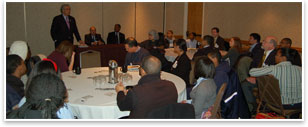 Summary: For the first time at the AIA’s Grassroots advocacy conference, the Institute hosted a Shadow an Architect program. It brought students from the Washington, D.C., Phelps Architecture, Engineering, and Construction High School to the conference and on a tour of the Washington Convention Center, led by a principal of the architecture firm that conceived it, 2008 AIA President Marshall Purnell, FAIA. Students then led their mentors on a tour of the Phelps school and presented their work, which spans every corner of the architecture, engineering, and construction industry. Summary: For the first time at the AIA’s Grassroots advocacy conference, the Institute hosted a Shadow an Architect program. It brought students from the Washington, D.C., Phelps Architecture, Engineering, and Construction High School to the conference and on a tour of the Washington Convention Center, led by a principal of the architecture firm that conceived it, 2008 AIA President Marshall Purnell, FAIA. Students then led their mentors on a tour of the Phelps school and presented their work, which spans every corner of the architecture, engineering, and construction industry.
“See all this wood?,” said Purnell, as he motions to the multi-planar and shelved surface of the convention center’s vast front interior wall, which his firm, Devrouax & Purnell, designed. “Two trees. It’s a veneer.”
“Nice,” said Spencer Leyh, admiring this economical application of room-warming bamboo-hued wood as he glanced from the interior wall to the late-morning sun streaming through the convention center’s front glass curtain wall.
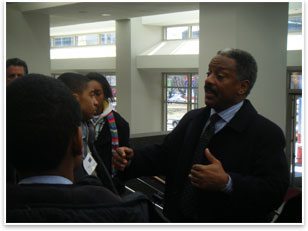 Purnell should be thankful for Leyh’s appreciation. He is one of a dozen or so 9th graders from Phelps, a District of Columbia public school, who toured the convention center with Purnell, and these students’ attention has been pulled in a lot of directions lately. At school, they have lots of choices. Phelps offers curricula in nearly all professions and trades associated with design and construction—engineering, interior design, plumbing, welding, HVAC, heavy machinery operation, and, of course, architecture—with facilities that would rival a community college; far above the vocational and professional capabilities of most high schools. Purnell should be thankful for Leyh’s appreciation. He is one of a dozen or so 9th graders from Phelps, a District of Columbia public school, who toured the convention center with Purnell, and these students’ attention has been pulled in a lot of directions lately. At school, they have lots of choices. Phelps offers curricula in nearly all professions and trades associated with design and construction—engineering, interior design, plumbing, welding, HVAC, heavy machinery operation, and, of course, architecture—with facilities that would rival a community college; far above the vocational and professional capabilities of most high schools.
This group of 9th graders are part of Phelps’ inaugural class and are the first to use their newly renovated building in Northeast D.C., which opened last fall. Their tour of the convention center was sponsored by the AIA’s Shadow an Architect program, as part of the annual AIA Grassroots advocacy conference.
Reaching out
The students began their day at a meeting room in Washington’s Grand Hyatt hotel, where the Grassroots conference was held. There, Purnell, Western Mountain Regional Director John Padilla, AIA, and a volunteer group of AIA mentors offered their time, energy, and enthusiasm for building a more diverse profession to the (mostly African-American) students. AIA First Vice President George Miller, FAIA, also spoke, offering encouragement to the students to continue their studies in the design professions and construction trades.
“Everybody’s always reached out to me,” Padilla told the students. “My commitment, and the commitment of the AIA and this program, is to make sure that we reach out to you.”
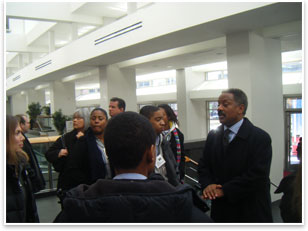 Purnell and Padilla said the first task of any architecture career program aimed at students is simply establishing awareness. “You’re pretty much letting them know the profession exists,” Purnell says. Purnell and Padilla said the first task of any architecture career program aimed at students is simply establishing awareness. “You’re pretty much letting them know the profession exists,” Purnell says.
The next task is to find a way for students to see themselves and people like them in the profession. “When I was growing up there was never anyone in the profession who looked like me,” said Padilla, a Latino-American. “If you see someone who looks like you, talks like you, walks like you, and they went through this and have the same background as you, all of those things begin to help.”
“When you feel as if you might want to give up or think ‘I’m the only person who ever went through this,’ it’s good to be able to pick up the phone and call somebody,” Purnell said. “They can tell you: ‘You’ll get through this.’”
Dispelling the myths
Other top priorities for the architect-mentors were dispelling the myths that architects have to be natural artists and top-notch mathematicians. “Students oftentimes look at their weaknesses rather than their strengths when they’re thinking about a profession, and I think it’s important to turn that upside down,” said mentor John Egan, AIA.
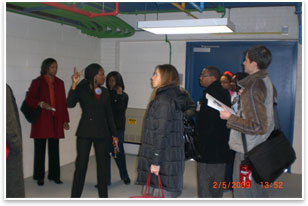 Students asked Purnell about the travel experiences architecture brought him to, and he spoke about visiting Red Square, carving his initials in the Great Wall of China, and seeing the Roman Coliseum. “When people study cultures, what do they show you?” Purnell asked the students. “They show you their architecture. They can tell you everything about an entire culture by what they build”—even if such cultural building motifs have been transplanted from one place to another. Purnell told students about the cultural history of the obelisk, from an African symbol, to the Greeks, to its adoption by Western thinkers during the Enlightenment, to its installation under vastly transformed cultural contexts into the National Mall as the Washington Monument. “The Washington Monument, as I see it, is the largest African-American symbol in the world,” he said. “It’s kind of appropriate that they’re going to put the National Museum of African-American History and Culture right next to it.” Students asked Purnell about the travel experiences architecture brought him to, and he spoke about visiting Red Square, carving his initials in the Great Wall of China, and seeing the Roman Coliseum. “When people study cultures, what do they show you?” Purnell asked the students. “They show you their architecture. They can tell you everything about an entire culture by what they build”—even if such cultural building motifs have been transplanted from one place to another. Purnell told students about the cultural history of the obelisk, from an African symbol, to the Greeks, to its adoption by Western thinkers during the Enlightenment, to its installation under vastly transformed cultural contexts into the National Mall as the Washington Monument. “The Washington Monument, as I see it, is the largest African-American symbol in the world,” he said. “It’s kind of appropriate that they’re going to put the National Museum of African-American History and Culture right next to it.”
Purnell also gave aspiring architects tips on how to ace their first job interview. The skills he prizes most: problem-solving and critical thinking, design potential, and—to the delight of the students’ teacher Olatundun Teyibo—the ability to write. “If you come into my office and you show me you can write well, there’s a role for you in what we do,” Purnell said.
“That was my favorite thing he mentioned,” said Teyibo, who is responsible for teaching the students survey courses that cover architecture, engineering, and construction during their first year. Even if they want to be welders or plumbers, she tells her students, they have to know how to write.
Multidisciplinary, interdiciplinary
After Purnell showed the students his work at the convention center, the students brought their mentors back to Phelps so that they could talk about their own projects. Phelps was designed by Fanning Howey and built by Turner Construction. And, as the architects and builders moved out and students moved in, the groups collaborated together. The architects and builders showed the students their plans and designs and spoke to classes, “using the building as a learning tool,” said Teyibo.
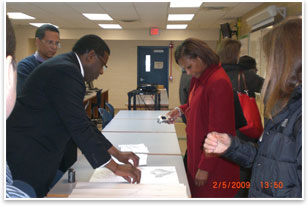 Students led their mentors through an atrium hallway that divides two brick buildings—the “T-school” where their technology and design labs are, and the academic building, which students pejoratively call their “real school.” The atrium’s arced glass ceiling and exposed brick are complete with black street-light-styled lamps form an urbane indoor street. You can hear birds chirp through the transparent ceiling, and there’s an adjacent enclosed courtyard. Students led their mentors through an atrium hallway that divides two brick buildings—the “T-school” where their technology and design labs are, and the academic building, which students pejoratively call their “real school.” The atrium’s arced glass ceiling and exposed brick are complete with black street-light-styled lamps form an urbane indoor street. You can hear birds chirp through the transparent ceiling, and there’s an adjacent enclosed courtyard.
The design intent of this community-inducing gesture isn’t lost on the students. “With different spaces that you make, you have to make people feel comfortable,” said 9th grader Phillicia Melton. “So I noticed that the interior designer—she was working with kids—so she had to make it bright and comfortable.”
Lots of labs
Beyond the atrium, the Phelps school contains a wide array of technology labs for electronics, welding, computers, heavy machinery simulation, and design. In each, generous skylights open up the ceiling and consistently color-coded utility lines snake across walls. In the school’s HVAC lab, students connect solar photovoltaic panels and experiment with scale-model houses wired with heating and cooling systems. Student Chieu-Ly Vo has worked on projects here, but she says her favorite assignment so far was designing the interiors for a college dorm room. However, she’d rather be an architect. “My favorite building is the Eiffel Tower in Paris, so I want to do exposed architecture like that.”
At the architecture lab, back issues of Architectural Record are stacked on a table, and Play-Doh models of performing arts venues line a countertop at the back of the room. Melton (who was accepted into the Phelps school by writing a descriptive essay about a Black History-themed amusement park) shows off her design—a terraced wedding cake-like plan. This is what she sees herself doing as a career. For now.
“My main thing is theater design,” she says. “I’ve been thinking about a lot of different things. I was thinking about doing welding. First it was engineering, then it was HVAC.”
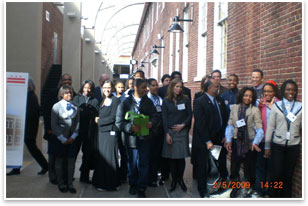 It’s Teyibo’s job to encourage this kind of fevered career wanderlust. “I like their confused state of mind,” she says with a laugh. “Every time they get exposed to a different unit, some of them change their minds.” It’s Teyibo’s job to encourage this kind of fevered career wanderlust. “I like their confused state of mind,” she says with a laugh. “Every time they get exposed to a different unit, some of them change their minds.”
Students at Phelps are most fascinated by the extremes of the design and construction spectrum: both the hands-on precision of soldering wires and joining pieces of metal and the theoretical open-endedness of designing an entire building. Their ability to mix these practice and design sensibilities will likely tell the story of their success as students at Phelps and, potentially, as architects.
Phelps student Donald Crosland has, in his first year of high school, come to understand the marketing condition that has been driving the design world in the modern era: big, iconic design ideas make big money. “I want to do hotels,” he says. “They’re the most exotic buildings now. With a school you can only do so much. You can’t really have a zig-zag school. You can have a hotel that lays. They attract attention like that.” |


 Summary:
Summary:

 Students asked Purnell about the travel experiences architecture brought him to, and he spoke about visiting Red Square, carving his initials in the Great Wall of China, and seeing the Roman Coliseum. “When people study cultures, what do they show you?” Purnell asked the students. “They show you their architecture. They can tell you everything about an entire culture by what they build”—even if such cultural building motifs have been transplanted from one place to another. Purnell told students about the cultural history of the obelisk, from an African symbol, to the Greeks, to its adoption by Western thinkers during the Enlightenment, to its installation under vastly transformed cultural contexts into the National Mall as the Washington Monument. “The Washington Monument, as I see it, is the largest African-American symbol in the world,” he said. “It’s kind of appropriate that they’re going to put the National Museum of African-American History and Culture right next to it.”
Students asked Purnell about the travel experiences architecture brought him to, and he spoke about visiting Red Square, carving his initials in the Great Wall of China, and seeing the Roman Coliseum. “When people study cultures, what do they show you?” Purnell asked the students. “They show you their architecture. They can tell you everything about an entire culture by what they build”—even if such cultural building motifs have been transplanted from one place to another. Purnell told students about the cultural history of the obelisk, from an African symbol, to the Greeks, to its adoption by Western thinkers during the Enlightenment, to its installation under vastly transformed cultural contexts into the National Mall as the Washington Monument. “The Washington Monument, as I see it, is the largest African-American symbol in the world,” he said. “It’s kind of appropriate that they’re going to put the National Museum of African-American History and Culture right next to it.”
 It’s Teyibo’s job to encourage this kind of fevered career wanderlust. “I like their confused state of mind,” she says with a laugh. “Every time they get exposed to a different unit, some of them change their minds.”
It’s Teyibo’s job to encourage this kind of fevered career wanderlust. “I like their confused state of mind,” she says with a laugh. “Every time they get exposed to a different unit, some of them change their minds.”